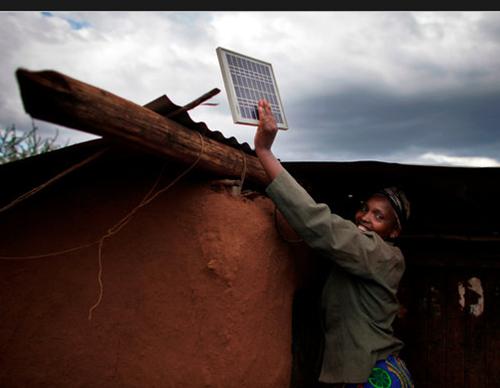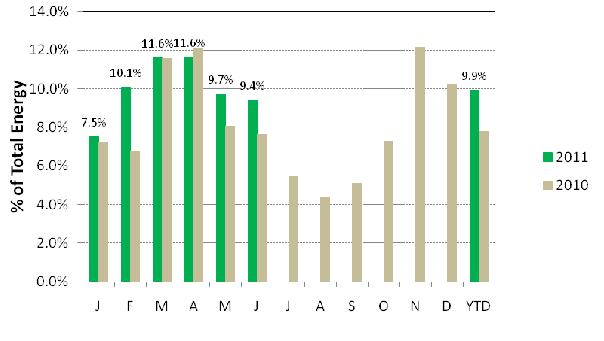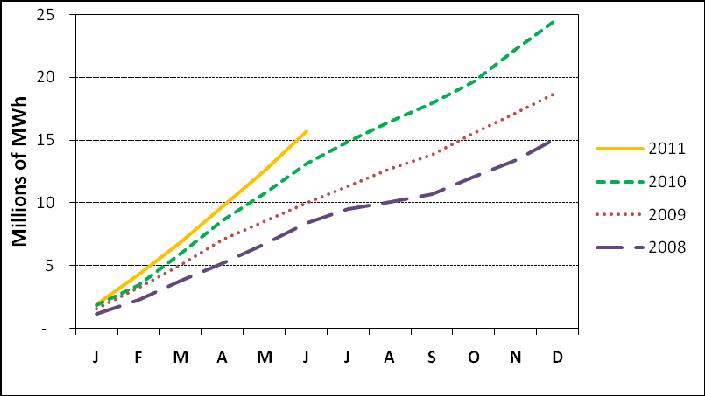Below is an article from the New York Times in its entirety showing the power for change renewable energy is having in third world countries. I think articles like this are a good argument for subscribing to papers like the New York Times.
African Huts Far From the Grid Glow With Renewable Power Beyond Fossil Fuels
by Ed Ou of The New York Times
 Thanks to this solar panel, Sara Ruto no longer takes a three-hour taxi ride to a town with electricity to recharge her cellphone. Click here to check out the slide show – Sustainable Energy Transforms Lives
Thanks to this solar panel, Sara Ruto no longer takes a three-hour taxi ride to a town with electricity to recharge her cellphone. Click here to check out the slide show – Sustainable Energy Transforms Lives
KIPTUSURI, Kenya — For Sara Ruto, the desperate yearning for electricity began last year with the purchase of her first cellphone, a lifeline for receiving small money transfers, contacting relatives in the city or checking chicken prices at the nearest market.
Solar power for Ms. Ruto’s hut in Kiptusuri, Kenya, means her toddlers no longer risk burns from a smoky kerosene lamp.
Charging the phone was no simple matter in this farming village far from Kenya’s electric grid.
Every week, Ms. Ruto walked two miles to hire a motorcycle taxi for the three-hour ride to Mogotio, the nearest town with electricity. There, she dropped off her cellphone at a store that recharges phones for 30 cents. Yet the service was in such demand that she had to leave it behind for three full days before returning.
That wearying routine ended in February when the family sold some animals to buy a small Chinese-made solar power system for about $80. Now balanced precariously atop their tin roof, a lone solar panel provides enough electricity to charge the phone and run four bright overhead lights with switches.
“My main motivation was the phone, but this has changed so many other things,” Ms. Ruto said on a recent evening as she relaxed on a bench in the mud-walled shack she shares with her husband and six children.
As small-scale renewable energy becomes cheaper, more reliable and more efficient, it is providing the first drops of modern power to people who live far from slow-growing electricity grids and fuel pipelines in developing countries. Although dwarfed by the big renewable energy projects that many industrialized countries are embracing to rein in greenhouse gas emissions, these tiny systems are playing an epic, transformative role.
Since Ms. Ruto hooked up the system, her teenagers’ grades have improved because they have light for studying. The toddlers no longer risk burns from the smoky kerosene lamp. And each month, she saves $15 in kerosene and battery costs — and the $20 she used to spend on travel.
In fact, neighbors now pay her 20 cents to charge their phones, although that business may soon evaporate: 63 families in Kiptusuri have recently installed their own solar power systems.
“You leapfrog over the need for fixed lines,” said Adam Kendall, head of the sub-Saharan Africa power practice for McKinsey & Company, the global consulting firm. “Renewable energy becomes more and more important in less and less developed markets.”
The United Nations estimates that 1.5 billion people across the globe still live without electricity, including 85 percent of Kenyans, and that three billion still cook and heat with primitive fuels like wood or charcoal.
There is no reliable data on the spread of off-grid renewable energy on a small scale, in part because the projects are often installed by individuals or tiny nongovernmental organizations.
But Dana Younger, senior renewable energy adviser at the International Finance Corporation, the World Bank Group’s private lending arm, said there was no question that the trend was accelerating. “It’s a phenomenon that’s sweeping the world; a huge number of these systems are being installed,” Mr. Younger said.
With the advent of cheap solar panels and high-efficiency LED lights, which can light a room with just 4 watts of power instead of 60, these small solar systems now deliver useful electricity at a price that even the poor can afford, he noted. “You’re seeing herders in Inner Mongolia with solar cells on top of their yurts,” Mr. Younger said.
In Africa, nascent markets for the systems have sprung up in Ethiopia, Uganda, Malawi and Ghana as well as in Kenya, said Francis Hillman, an energy entrepreneur who recently shifted his Eritrea-based business, Phaesun Asmara, from large solar projects financed by nongovernmental organizations to a greater emphasis on tiny rooftop systems.
In addition to these small solar projects, renewable energy technologies designed for the poor include simple subterranean biogas chambers that make fuel and electricity from the manure of a few cows, and “mini” hydroelectric dams that can harness the power of a local river for an entire village.
Yet while these off-grid systems have proved their worth, the lack of an effective distribution network or a reliable way of financing the start-up costs has prevented them from becoming more widespread.
“The big problem for us now is there is no business model yet,” said John Maina, executive coordinator of Sustainable Community Development Services, or Scode, a nongovernmental organization based in Nakuru, Kenya, that is devoted to bringing power to rural areas.
Just a few years ago, Mr. Maina said, “solar lights” were merely basic lanterns, dim and unreliable.
“Finally, these products exist, people are asking for them and are willing to pay,” he said. “But we can’t get supply.” He said small African organizations like his do not have the purchasing power or connections to place bulk orders themselves from distant manufacturers, forcing them to scramble for items each time a shipment happens to come into the country.
Part of the problem is that the new systems buck the traditional mold, in which power is generated by a very small number of huge government-owned companies that gradually extend the grid into rural areas. Investors are reluctant to pour money into products that serve a dispersed market of poor rural consumers because they see the risk as too high.
Beyond Fossil Fuels
Starting Small
Articles in this series examine innovative attempts to reduce the world’s dependence on coal, oil and other carbon-intensive fuels, and the challenges faced.
On a Small Scale, Sustainable Energy Transforms Lives
“There are many small islands of success, but they need to go to scale,” said Minoru Takada, chief of the United Nations Development Program’s sustainable energy program. “Off-grid is the answer for the poor. But people who control funding need to see this as a viable option.”
Even United Nations programs and United States government funds that promote climate-friendly energy in developing countries hew to large projects like giant wind farms or industrial-scale solar plants that feed into the grid. A $300 million solar project is much easier to finance and monitor than 10 million home-scale solar systems in mud huts spread across a continent.
As a result, money does not flow to the poorest areas. Of the $162 billion invested in renewable energy last year, according to the United Nations, experts estimate that $44 billion was spent in China, India and Brazil collectively, and $7.5 billion in the many poorer countries.
Only 6 to 7 percent of solar panels are manufactured to produce electricity that does not feed into the grid; that includes systems like Ms. Ruto’s and solar panels that light American parking lots and football stadiums.
Still, some new models are emerging. Husk Power Systems, a young company supported by a mix of private investment and nonprofit funds, has built 60 village power plants in rural India that make electricity from rice husks for 250 hamlets since 2007.
In Nepal and Indonesia, the United Nations Development Program has helped finance the construction of very small hydroelectric plants that have brought electricity to remote mountain communities. Morocco provides subsidized solar home systems at a cost of $100 each to remote rural areas where expanding the national grid is not cost-effective.
What has most surprised some experts in the field is the recent emergence of a true market in Africa for home-scale renewable energy and for appliances that consume less energy. As the cost of reliable equipment decreases, families have proved ever more willing to buy it by selling a goat or borrowing money from a relative overseas, for example.
The explosion of cellphone use in rural Africa has been an enormous motivating factor. Because rural regions of many African countries lack banks, the cellphone has been embraced as a tool for commercial transactions as well as personal communications, adding an incentive to electrify for the sake of recharging.
M-Pesa, Kenya’s largest mobile phone money transfer service, handles an annual cash flow equivalent to more than 10 percent of the country’s gross domestic product, most in tiny transactions that rarely exceed $20.
The cheap renewable energy systems also allow the rural poor to save money on candles, charcoal, batteries, wood and kerosene. “So there is an ability to pay and a willingness to pay,” said Mr. Younger of the International Finance Corporation.
In another Kenyan village, Lochorai, Alice Wangui, 45, and Agnes Mwaforo, 35, formerly subsistence farmers, now operate a booming business selling and installing energy-efficient wood-burning cooking stoves made of clay and metal for a cost of $5. Wearing matching bright orange tops and skirts, they walk down rutted dirt paths with cellphones ever at their ears, edging past goats and dogs to visit customers and to calm those on the waiting list.
Hunched over her new stove as she stirred a stew of potatoes and beans, Naomi Muriuki, 58, volunteered that the appliance had more than halved her use of firewood. Wood has become harder to find and expensive to buy as the government tries to limit deforestation, she added.
In Tumsifu, a slightly more prosperous village of dairy farmers, Virginia Wairimu, 35, is benefiting from an underground tank in which the manure from her three cows is converted to biogas, which is then pumped through a rubber tube to a gas burner.
“I can just get up and make breakfast,” Ms. Wairimu said. The system was financed with a $400 loan from a demonstration project that has since expired.
In Kiptusuri, the Firefly LED system purchased by Ms. Ruto is this year’s must-have item. The smallest one, which costs $12, consists of a solar panel that can be placed in a window or on a roof and is connected to a desk lamp and a phone charger. Slightly larger units can run radios and black-and-white television sets.
Of course, such systems cannot compare with a grid connection in the industrialized world. A week of rain can mean no lights. And items like refrigerators need more, and more consistent, power than a panel provides.
Still, in Kenya, even grid-based electricity is intermittent and expensive: families must pay more than $350 just to have their homes hooked up.
“With this system, you get a real light for what you spend on kerosene in a few months,” said Mr. Maina, of Sustainable Community Development Services. “When you can light your home and charge your phone, that is very valuable.”
Read Full Post »
 It pleases me to see good organizations such as SEIA leaving the backward notions of ALEC behind and I hope that other well-meaning organizations, businesses and elected officials will take a hard look at the facts and do the same. ALEC has perverted the legislative process to suit its needs. Model bills are developed behind closed doors to fit certain member industry desires and are then pushed for adoption in as many states as possible. Of course, as SEIA has likely discovered, not all members are equal and its the big boys that get to make the rules of the game.
It pleases me to see good organizations such as SEIA leaving the backward notions of ALEC behind and I hope that other well-meaning organizations, businesses and elected officials will take a hard look at the facts and do the same. ALEC has perverted the legislative process to suit its needs. Model bills are developed behind closed doors to fit certain member industry desires and are then pushed for adoption in as many states as possible. Of course, as SEIA has likely discovered, not all members are equal and its the big boys that get to make the rules of the game.











